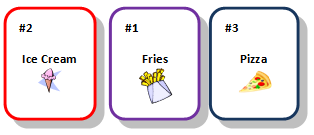The opinions expressed by the bloggers below and those providing comments are theirs alone, and do not necessarily reflect the opinions of Ryma Technology Solutions. As they say, you can't innovate without breaking a few eggs...
- Font size: Larger Smaller
- Hits: 24002
- 3 Comments
- Subscribe to this entry
- Bookmark
Customer Needs: Finding Out What Lies Beneath
‘What Men and Women Really Want’ - that was the question attempted to be answered by an article I was recently sent to read – and while the busy infographic hurt my eyes, and the answers themselves amused me, what I really found interesting was the means of getting the answers.
Social media monitoring company NetBase had gathered up, then sliced and diced, a year’s worth (over 27 billiion) of online conversation to come up with a summary of the results presented in a brightly coloured and large infographic.
And as I said, it wasn’t really the results that impressed me, it was more the method used to obtain the results – and what it could mean for gathering market evidence in the future.
To obtain the results, men and women were not directly asked what they want - Netbase simply took their naturally occurring conversations and derived what they want. Interesting concept, isn’t it? I wonder what men and women might have answered were they asked directly – how many times have we seen an article on what men and women want that include the words “of the men polled” or “of the women who filled out the survey” – which yes, their answers must tell us what they think they want – but is that really what they want? Or at least, is it everything they want? And need?
Fast forward to Wednesday when I tuned into a webinar given by Keith Goffin, on ‘Identifying Customer’s Hidden Needs’ and it started to come together even more.
In Keith’s webinar, he discusses techniques to uncover what he refers to as people’s hidden needs – the needs not outwardly identified by previous market sensing efforts or even by the customer’s themselves – but needs that exist beneath the surface at the subconscious level - and that when provided for can result in one very happy customer.
Specifically, Keith discussed two particular methods which can be used to find out what these hidden needs might be: repertory grid and ethnographic market research.
Since I liked the repertory grid technique best, let’s play the repertory grid game!
Okay, pretend you are my customer and I just asked you to name six food products – and here are six cards each randomly numbered and representing a food items that you told me:

How does the third food differ from those two?

And maybe you would have answered something like french fries and pizza are similar because they are easy to eat with your hands, and ice cream differs because it is messy to eat with your hands. And then I would have asked you a series of similar questions all comparing and contrasting two of them to the third.
And for each type of construct or description you came up with we would go through and rate each product in that particular area. For example, to indicate how messy the food is to eat with your hands, or how quick it is to prepare each one, or which one is fun to eat, etc. etc. – so that in the end what we would have is a grid with all the products listed and a rating for each type of construct mentioned.
For example maybe we end up with something like this:

Looking at the above ratings, and considering the higher the number the worse the rating – we can start to see where there could be areas for improvement.
For example, people love eating ice cream (women more so according to that infographic) but it’s not considered healthy – perhaps that’s an area for improvement. Or people love eating pizza, but don’t find it that quick to prepare – perhaps also an area for improvement in this particular example.
Now we might ask – well why not just ask people how easy they find it to prepare pizza, or how easy they find it to eat french fries with their hands – and we very well could, but the biggest difference between doing that and the exercise we just stepped through is that all the constructs, all the areas to which we can possibly improve, came from the customers themselves – and a lot of times the areas that customers inherently talk about when discussing a product will not even be thought of by a company when doing normal interviews, surveys or focus groups. There is value in letting the customer drive the conversation.
Similar to the infographic which summarized what men and women by looking at their naturally occurring everyday conversations, the repertory grid technique of eliciting customer needs, digs into a customer’s subconcious and finds the information beneath the surface – in other words, it finds the hidden needs.
Interestingly enough, my interest was also piqued on this topic a few months ago when I read an article on the idea of neuro-marketing and the use of fMRI scanning to determine what people really want, or like in products. For those who are not science geeks like myself, an fMRI is the same technology used in a lie detector test, and studies the flow of blood in the brain – so in the context of determining what people like or want, the fMRI can be used to determine products and ideas that the brain reacts to. And how do we know if it is reacting positively or negatively you ask? Turns out it can also determine the level of oxygen in the blood during the reaction and detect the type of activity associated with that level – fear, pleasure, reasoning, etc. Pretty neat, right?
So instead of something like a focus group where customers are paid to answer direct questions – customers are simply shown products or product concepts, and the fMRI machine will do the rest, letting us know which of the products and ideas stimulate the brain and how it stimulates it.
Going back to the ‘What Men and Women Want’ infographic, it was determined that the number one car men want is a Ford. Yes, a Ford! Now, what guy do you know that when asked what his dream car is, will say ‘Oh man, I would just LOVE at some point in my life to have a Ford!’. Not any that I know. But rest be assured the next time a man talks to me about how much he wants a BMW or a Porsche, I will just smile and try to keep my laughter to a minimum, knowing very well that what he really wants is a Ford. And I bet if an fMRI could laugh, it would as well.
Granted, I don’t know too many customers who would welcome being hooked up to a machine in order to read their mind (voluntarily anyways), but hey, that’s what product management is for – and I’m sure one day a more practical form of the fMRI will be available for use.
Neuro-marketing, repertory grid, social media analysis, and other similar methods, all tap into our subconscious where - despite what we may want to believe - is where the majority of our decision-making is actually done. Studies have shown that our subconscious has actually predicted the outcome of a decision up to several seconds before our conscious mind even realizes it! And using any of these techniques simply recognizes that fact – that it’s quite possible that we ourselves do not really know what we want and need.
So given that possibility, maybe it’s time we start adding to the list of market sensing activities more popularly used today, and try to tap more into the subconscious mind of our customers, not just the conscious.
What do you think? Do you have any experience using these methodologies or would they be something you would use to determine the needs of your customers?
Comments
-
 Tuesday, 20 March 2012
Tuesday, 20 March 2012I think that makes a lot of sense and is along the same lines of what I mention in the post. It can definitely be tricky to tell the reasons people are giving you positive answers (or negative ones too really) - especially when being put on the spot to answer a direct question. Keeping it to a general topic and letting them bringing the important points/features to the surface sounds like a good idea to me!
Thanks for sharing, I find the topic interesting and enjoy hearing about the different approaches companies are using.









A big mistake I see people make when interviewing to understand demand / requirements is asking questions that are too direct, too blunt.
"Would you be interested in feature X?"
This will get a collection of positive responses, but then it can be tricky to differentiate how positive they are. You need to work out whether "Yes" means "Sound kind of interesting I can see how that might be us for some people" vs "Oh my god that would save me an hour a day"
Instead of asking directly, I find it's more useful (scientific?) to ask them about a general topic, and what they do now.
- If the feature is important they will raise it without a direct prompt.